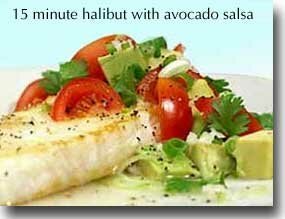healthy food tip and recipe
Today's Recipe
If you don't know what to serve for dinner tonight ...
Get an extra boost of lycopene from the tomatoes and heart-healthy monounsatured fats from the avocados in this great addition to your Healthiest Way of Eating.

Ingredients:
- 6 medium cloves garlic, pressed
- 1/4 cup minced scallion
- 1-2 tsp finely minced jalapeno pepper
- 3 TBS chopped fresh cilantro
- 8 cherry tomatoes, quartered
- 1 medium ripe but firm avocado, diced into 1/4-inch cubes
- 1/4 cup + 1 TBS fresh lemon juice
- 4 6 oz halibut steaks or fillets
- salt and black pepper to taste
- Press garlic and let sit for 5 minutes to bring out its health-promoting properties.
- Mix together garlic, scallions, jalapeno pepper, cilantro, tomatoes, avocado, 1/4 cup lemon juice, and salt and pepper to taste. Set aside.
- Heat 2 inches of water in the bottom of a steamer and let it come to a boil.
- Rub halibut with 1TBS lemon juice and season with a little salt and black pepper. Place in steamer and steam 10 minutes for every inch of thickness. (e.g., 5 minutes if it is 1/2-inch thick)
- Place fish on plate, and top with salsa.
Printer Friendly Version of 15-Minute Halibut with Avocado Salsa
In-Depth Nutritional Profile for 15-Minute Halibut with Avocado Salsa
Healthy Food Tip
What is the difference between different types of salt such as kosher salt, sea salt, iodized salt, and regular salt?
The differences between types of salt-kosher salt, sea salt, iodized salt, and regular table salt-are a little more complicated than you might expect. In terms of its chemical structure, salt is a crystal composed of the elements sodium and chloride. While these two elements give salt its basic chemical structure, there are about one million trillion sodium-plus-chloride pairs in a single grain of salt.
There are three basic ways to obtain salt. First, salt can be mined since it is part of natural rock formations like halite. This mined salt can be processed and converted into ordinary table salt. Second, salt can be obtained from the ocean and produced by evaporating the water and leaving behind the salt. This salt can also be processed to produce a sea salt that looks and feels basically identical to table salt. However, because there are often additional minerals left following the evaporation of the sea water, sea salt can provide a little more nourishment in this context than other forms of salt. Third, salt can be produced from scratch in a science lab, although you won't see this type of salt in the grocery store because the other ways to obtain salt are much cheaper.
From the standpoint of religious dietary laws, "kosher salt" is somewhat of a misleading term since all pure salt would technically be considered kosher because of its purely mineral (sodium plus chloride) composition. This rule would apply to all pure salt, whether it was originally obtained from sea or land. However, in a practical, everyday sense what makes kosher salt different is its size and shape. Whether obtained from sea salt or mined salt, kosher salt production takes place with an alteration in the evaporation process that result in much larger and irregular chunks of salt.
What is the advantage of these larger-sized chunks? There is no nutritional advantage related to size, but kosher salt gets its name because it was originally designed to help in the koshering of meats. Koshering meat is a very important process in the dietary laws of several religions (especially Judaism), and many different factors are required in order for a meat to be considered kosher. One of these factors is the careful removal of all blood from the animal. Kosher salt-because of its larger grain size-dissolves more slowly when it is used to cure freshly cut meat. For this reason, it can do a better job drawing the blood out from the still uncooked meat. (If it were much bigger, however, the blood would simply spill off of it.)
Unrelated to this meat koshering process, however, many cooks like to use kosher salt because its larger size is simply more convenient and practical for certain kinds of food preparation. If you decide to cook with kosher salt, you'll need to follow the manufacturer's instructions about conversion of the fine-grained table salt amount in your recipe to the larger-grained kosher salt amount. There isn't one simple conversion method for substituting table salt with kosher salt because different manufacturers make kosher salts with grains that are always larger but vary significantly in size.
Any version of salt can be iodized or non-iodized. In the United States, iodized salt was introduced into the marketplace in the early 1920's in an effort to help lower the incidence of goiter. Goiter is a condition in which the thyroid gland enlarges to try and maintain its optimal function, and one possible cause of goiter is dietary iodine deficiency. The way salt is iodized is usually very simple and involves the addition of an iodine-containing mineral salt (like potassium iodide) to the sodium chloride. Sea salt, kosher salt, and regular table salt can all be purchased in iodized or non-iodized versions. To know whether you'd be better off purchasing iodized or non-iodized salt, it's important to know how effectively your diet is providing you with iodine.
For more information on this topic see:



No comments:
Post a Comment